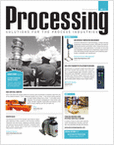Friday, February 20, 2009
Display problem ? Click HERE
Recommended :
- Tips on Succession in FREE Subscription
- Subscribe FREE - Processing Magazine

Smokeless flaring is one of the common requirement for open flare to ensure proper combustion of relief gases and minimize greenhouse effect and pollution. Smokeless flaring may be achieved by direct air blowing, steam injection, water injection, pressure energy to create turbulence, etc. Minimum requirement of smokeless flaring is determined by local authority or company policy. One of the way to quantify smokeless is using Ringlemann number.

The Ringelmann Smoke Chart, giving shades of gray by which the density of columns of smoke rising from stacks may be compared, was developed by Professor Maximilian Ringelmann of Paris. The Ringelmann Chart was used by the engineers in their studies of smokeless combustion. The chart is now used as a device for determining whether emissions of smoke are within limits or standards of permissibility (statutes and ordinances) established and expressed with reference to the chart. It is widely used by law-enforcement or compliance officers in jurisdictions that have adopted standards based upon the chart.- Tips on Succession in FREE Subscription
- Subscribe FREE - Processing Magazine

Smokeless flaring is one of the common requirement for open flare to ensure proper combustion of relief gases and minimize greenhouse effect and pollution. Smokeless flaring may be achieved by direct air blowing, steam injection, water injection, pressure energy to create turbulence, etc. Minimum requirement of smokeless flaring is determined by local authority or company policy. One of the way to quantify smokeless is using Ringlemann number.

The Ringelmann system is virtually a scheme whereby graduated shades of gray, varying by five equal steps between white and black, may be accurately reproduced by means of a rectangular grill of black lines of definite width and spacing on a white background. The rule given by Professor Ringelmann by which the charts may be reproduced is as follows:
Card 0—All white.
Card 1—Black lines 1 mm thick, 10 mm apart, leaving white spaces 9 mm square.
Card 2—Lines 2.3 mm thick, spaces 7.7 mm square.
Card 3—Lines 3.7 mm thick, spaces 6.3 mm square.
Card 4—Lines 5.5 mm thick, spaces 4.5 mm square.
Card 5—All black.
The chart provides the shades of cards 1, 2, 3, and 4 on a single sheet, which are known as Ringelmann No. 1, 2, 3, and 4, respectively. Refer following samples.
Minimum requirement of smokeless flaring is determined by local authority or company policy. Generally onshore plant required Ringlemann 0 (normal operation) and Ringlemann 1 (Emergency) whilst offshore facilities may required Ringlemann 0 (normal operation) and Ringlemann 2 (Emergency).
Download detail report and chart
Related Topic
Download detail report and chart
Related Topic
Labels: Combustion, Flare

0 Comments:
Post a Comment
Let us know your opinion !!! You can use some HTML tags, such as <b>, <i>, <a>
Subscribe to Post Comments [Atom]
Home:
<< Home